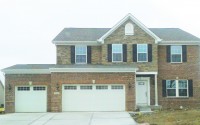Home Guru: From Horse and Buggy to Automatic Garage Door Openers

If you’re like me, you pull into and out of your garage every day without thinking much about it. Usually I fumble for the automatic garage door opener, which I never have assigned to a particular place in my car, but the rest is as automatic as driving.
There have been problems with that, such as the innumerable times I’ve mindlessly detached my side view mirrors and streaked my car with paint by sideswiping the door jams. Or better yet, when I attempted to back out of my garage with the door closed, crashing halfway through the door and removing an entire corner of the structure.
When the carpenter arrived to repair the damage, he said, “Your wife did this, right?” And shamelessly I lied, “Yeah, right.”
Just as automobiles changed the way we travel, the garage has changed the way our homes look more than any other element, rendering them at least 25 percent larger and more than that if you consider the “bonus” room that can be built above.
Readers of this column know how I tend to fixate more on the history of things than how they operate, and so it is with the garage. Where exactly did it come from? The very word didn’t even exist until the beginning of the 20th century when it was coined from the French word garer meaning to shelter.
At that time, the early automobile had to share the carriage house or stable where buggies and horses were still kept, resulting in a weird transitional phenomenon in which the cars smelled of horse manure when they were taken out for a spin. Eventually, the automobile claimed its own exclusive space.
As early as the 1920s, real estate industry sources were saying that houses without garages were slower to sell. It’s still the case today. Most people want a garage when they buy.
For protection from the elements, separate outbuildings used as garages were first attached by a breezeway to the main house but were eventually incorporated into the footprint of the house itself. Along the way, a couple of neat inventions sped the modern garage’s development, namely the folding overhead garage door invented by C. G. Johnson in 1921. In 1926, Johnson also invented the electric door opener.
Garage doors were originally made of wood, and some still are, but by the 1970s they were constructed of galvanized steel, then fiberglass, followed by composites like resin-filled wood and eventually vinyl-covered aluminum. For ultimate convenience, the automatic garage door opener appeared prominently in the early 1960s, although it had been invented decades earlier.
Today, garages can serve many functions other than housing cars. One of my neighbors uses a three-bay garage as a museum of vintage cars, each with a crystal chandelier. Another, in a house I listed, serves as a combination office and workshop, which is impeccably clean and more organized from its painted floor to its stacks of glistening shelves than any professional office.
My garage, by comparison, looks like Pandora’s box, ready to explode, just one year after it was cleaned out by a professional organizer who was told by my wife to “throw out everything but the cars.”
Many garages are used as workshops, workout rooms and even business start-ups. Where do you think Apple, Google, Dell, Nike and Mattel got their starts? But mostly, we all harbor items there that don’t fit elsewhere in our homes. In my case, it is the repository for my garden tools, since I don’t have a shed (although I’ve planned for many years to buy one), and for my real estate paraphernalia, recyclables and a variety of discarded items waiting for bulk pick-up.
Some consider the garage a boon and others an eyesore, especially when it becomes the major focus of its facade, all but obscuring the front entrance. In my town, the architectural review board on which I serve prefers that garage doors face out from the side of the house rather than the front.
Most architects with whom I’ve discussed garages would prefer that they be separated from the main house once again, perhaps connected by a breezeway for convenience, but homebuyers always prefer that they be incorporated into the footprint of the house, either in front, to the side or underneath.
I have no preferences about how or where to construct a garage or how to use it, but I would always advise car owners to buckle up before backing out and, oh yes, make sure the garage door is open.
Bill Primavera is a licensed Realtor® associated with Coldwell Banker and a lifestyles columnist who writes regularly as The Home Guru. For those seeking advice on home maintenance or who want to buy or sell a home, visit his website, www.PrimaveraHomes.com, or call him directly at 914-522-2076.


